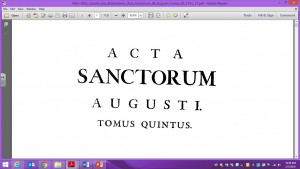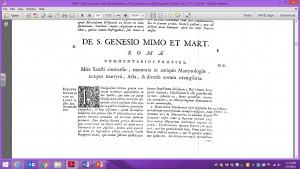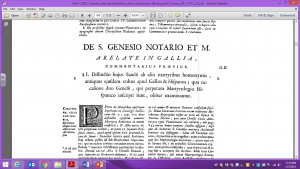February 8, 2016 by Jared Wielfaert
The Search for St. Genesius: Navigating the Acta Sanctorum
In my previous post, I learned what I could from a Google search of “Genesius of Arles.” My search quickly led me to online encyclopedia entries ultimately derived from the erudite inquiries of seventeenth, eighteenth, and nineteenth century researchers. We benefit enormously from the monumental labor of these earlier scholars. Fortunately, much of their work, previously available only in large research libraries, is now found online.
In this post, I am using the work of the Bollandists to access the earliest textual witnesses to the life, martyrdom and cult of Saint Genesius.
The Bollandists:
The Bollandists were a society of Catholic (mostly Jesuit) historians, philologists, and archaeologists who set modern investigation into the lives and deeds of the saints on a scientific footing.
Between 1643-1925, the Bollandists produced a multi-volume compilation of investigations into the textual and archaeological evidence for saints listed in the Roman calendar, along with many obscure local and regional saints. The modern Société de Bollandists maintains an English-language website with updates on the society’s membership and most recent publications and projects. But the most significant Bollandist research remains the work completed in the seventeenth, eighteenth, and nineteenth centuries, particularly in the multi-volume Acta Sanctorum.
Acta Sanctorum
The Acta are a sixty-one volume encyclopedia of saints, organized around the liturgical calendar, with each saint listed according to his or her feast day (beginning with Jan. 1 in Volume 1, Tome 1). The volumes of Acta Sanctorum have been digitized and are fully searchable through a collection published by http://acta.chadwyck.co.uk/ (Unfortunately, Lee University does not presently maintain a subscription to this collection).
Digital facsimiles of twentieth-century reprints of the original folio volumes (1-61) are archived here (at Documenta Catholica Omnia via Google Books scans) and here (higher resolution, but less navigable scans, published by the Bibliotheque Nationale de France (BNF))
Searching Saint Genesius
In order to locate Saint Genesius in the Acta Sanctorum, I need to know his feast day. The feast day (in this case August 25) is usually the date of the saint’s death, called the “dies natalis,” since it is also the date of the saint’s “birth” into heaven. To locate Genesius in the .pdf scans of the Acta, maintained by Documenta Catholica Omnia, I click through the link then scroll down to the volumes for August.
The Acta for August include six tomes (or volumes), roughly 1 for every 5 days. So I venture a guess: Genesius is likely in tome 5 (of 6). After clicking on the link, I wait for the .pdf to load, then begin to scroll through the volume to search for my saint’s “dies natalis.” The heading will appear as “die vigesima quinta Augusti,” “on the twenty-fifth day of August.”
I guess correctly. The volume begins “die vigesima quinta Augusti” and proceeds alphabetically through the saints whose feasts are celebrated on the 25th. After scrolling through a lengthy entry on Saint Bartholomew the Apostle and shorter entries on S. Geruntius, Bishop, and the Roman Martyrs Eusebius, Pontianus, Vincentius, and Peregrinus, I find that there are two Genesiuses who share a feast day.
The first is Genesius, Mime and Martyr (Genesius of Rome). My earlier research has prepared me for the possible confusion of Genesius of Arles with Genesius of Rome (a contemporary saint whose life and death seemed modeled on my Genesius). For now, I scroll through both the Vita and the Passio of Genesius of Rome.
Eventually, on p. 123, I locate S. Genasius, Notary and Martyr, that is, Genesius of Arles.
The Acta Sanctorum entry on Genesius runs for 13 pages (each page containing two columns of cramped script). The majority of the entry consists of scholarly investigation into the identity of the saint and the question of his identification with the two other saints of the same name whose days are celebrated on August 25. A full assessment will require a slow and careful reading of the full entry. But an outline of the entry is as follows:
Outline of The Acta Sanctorum Entry on Genasius of Arles:
De S. Genesio Notario et M. [On St. Genesius Notary and Martyr]
Arelate in Gallia. [At Arles in Gaul]
Commentarius Praevius. [Prefatory Commentary]
I. Distinctio huius Sancti ab aliis martyribus homonymis, antiquus ejusdem cultus apud Gallos et Hispanos ; qua occasione duo Genesi, qui perperam Martyrologio Hispanico inscripti sunt, obiter examinantur. (pp.123-126)
[Distinguishing this saint from other martyrs of the same name ; the ancient worship (cult) of the same saint in Gaul and in Spain; at which time, the two Genesiuses, which are wrongly inscribed in Spanish Martyrology, are, along the way, examined.]
II. Indagatur, quis aut qualia fuerit sanctus Genesius, qui in Carthaginensi Hispaniae provincia apud PP. Minoritas Sciarenses hodie colitur. (pp. 126-129)
[It is searched out who and what sort of person the St. Genesius was who is venerated today by a congregation [PP. Minoritas Sciarenses] in the province of Cartagena, Spain.
III. Sincera sancti Martyris Arelatensis Acta, dubius eorum scriptor, incertus martyrs annus et duplex Arelatensium traditio refutata.
The genuine Acta of the martyrs of Arles, the dubious scribe of the same Acta, the uncertain year of the martyr’s death, and the double tradition of Arles refuted.
IV. Diversa miracula patrocinio Sancti post martyrium ejus patrata, et ab auctoribus fide dignissimis conscripta.
The diverse miracles attributed to the patronage of the saint after his martyrdom and faithfully written down by very trustworthy authors.
ACTA [pp. 135-136]
The Deeds of the Martyr
auctore Paulino episcopo
By the author Paul the Bishop
Ex Actis Martyrum sinceris et selectis, qua Ruinartius anno 1689 Parisiis edidit, et qua cum alias Mss. contulimus, pag. 603 et sequentibus.
From the genuine and selected deeds of the Martyrs, which Ruinart edited in Paris in 1689, and from with we have collated with other manuscripts, beginning at page 603 and following.
“Proprium atque indigenam Arelatensis urbis . . .”
[I am include the first five words of the text that follows. In Latin this is called the “Incipit,” which means “Here begins.” In the Middle Ages many texts circulated without titles and would have been known only by their incipits.]
A quick attempt to skim the contents of the editor’s introduction reveals the following:
• Medieval and early modern hagiographers have erroneously conflated Genesius, martyr of Arles, with Genesius of Rome, mime [the Bollandists maintain two separate traditions and accept the historicity of each].
• There are at least four additional homonymic Saints [besides Genesius of Rome] whose lives were commemorated in the middle ages.
They include:
- “Genesius, martyred at the castle of Tigernense.”
- “Genesius, the 25th bishop of Clermont”
- Genesius Beorritanum, martyr [“who is unknown in various martyrologies”]
- “Genesius, the monk, impiously killed by the Danes” [added by Saussay in his appendix to the Gallican Martyrology, [tome 2, p. 1223].
• Genesius is listed in the Martyrology of Jerome. He is also found in three martyrologies of the ninth century: 1. the Martyrology of Ado of Vienne (d. 874); Martyrology of Usuard (d. 877) and 3. the verse martyrology of Wandelbertus of Prüm (d. 850).
• He appears in the Mozarabic Liturgy with a hymn in commemoration of his office (the full text is printed in the Acta Santorum)
• He is also listed in a sixth century North African Martyrology (which preserves his liturgical commemoration at Carthage).
• The earliest Acta are attributed to Paulinus of Nola (whose authorship the Bollandists uphold).
• His deeds and posthumous miracles are partially described in the works of Hilary of Arles and Gregory of Tours and allusions to him are found in the verse of Prudentius, Venantius Fortunatus, and several other late antique and early medieval authors [ for full list, see pp. 124 E – 126 F]
• The entry concludes with the Acta, which the Bollandists maintain were written by Paulinus of Nola (they are edited from a 1689 edition by Thierry Ruinart). The Acta attributed to Paulinus are brief, running to little more than 4 columns. (In a subsequent post I will work to locate a complete English translation. In the meantime, I begin my own translation from the Latin.)
It will take some time to work through each of these leads individually. For a thorough study of Genesius, I would want to locate modern critical editions for as many of the above references as possible. In the meantime, I will consult the searchable website of the BHLms for a full list of extant hagiographical texts related to Genesius’s cult.
Next: Searching Genesius in the BHLms





Leave a Reply